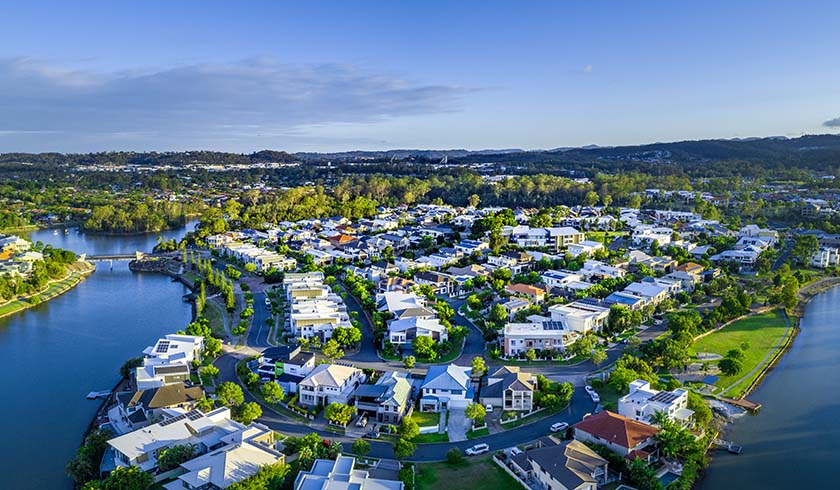August data proves property value gains are slowing down
The monthly rate of property price growth looks to finally be calming down, new analysis has found.

Latest figures from CoreLogic revealed that national dwelling values rose by 1.5 per cent in August. While that’s still above average, this is the lowest monthly rise recorded since January 2021.
According to CoreLogic’s research director, Tim Lawless, the newest results provide confirmation that the rate of price growth is moderating after moving through a peak in March 2021, when national home values rose by 2.8 per cent.
Mr Lawless has attributed the loss of momentum to the worsening affordability constraints, as “housing prices [increased] almost 11 times faster than wages growth over the past year, creating a more significant barrier to entry for those who don’t yet own a home”.
“Lockdowns are having a clear impact on consumer sentiment; however, to date, the restrictions have resulted in falling advertised listings and, to a lesser extent, fewer home sales, with less impact on price growth momentum,” the researcher added.
This shortage of properties available for purchase will likely drive further upwards pressure on housing values, thus leading to a greater decline in affordability, he said.
Across the capital cities, Hobart led price growth with an increase of 2.3 per cent, followed by Canberra with 2.2 per cent, Brisbane with 2 per cent, Adelaide with 1.9 per cent, Sydney with 1.8 per cent and Melbourne with 1.2 per cent. Only Darwin saw a decline at 0.1 of a percentage point.
Annual results: more positive
While the monthly growth rate has dropped to a record low nationally, the annual growth rate provides a more positive insight for individuals playing the longer game.
According to CoreLogic, housing values rose by 18.4 per cent from August 2020, approximately $103,400 or $1,990 per week. In comparison, Australian wages rose at the average annual rate of 1.7 per cent over the same period.
Mr Lawless said this was the fastest annual pace of growth in housing values since the year ended July 1989.
“Through the late 1980s, the annual pace of national home value appreciation was as high as 31 per cent, so the market isn’t quite in unprecedented territory,” he said.
“The annual growth rate at the moment is trending higher — in fact, it is 3.6 times higher than the 30-year average rate of annual growth.”
Annually, regionals continued to see a higher average growth at 21.6 per cent compared with capital cities, which recorded a slightly lower 17.5 per cent.
Of the capital cities, Hobart still held the pole position with growth of 24.5 per cent, followed by Canberra with 22.5 per cent, Darwin with 22 per cent, Sydney with 20.9 per cent, Brisbane with 18.3 per cent, Adelaide with 17.9 per cent and Melbourne with 13.1 per cent.
But despite being overtaken by smaller capitals, Sydney continues to be the most expensive housing market, with a median of $1,039,514.
This was followed by Canberra with $816,644, Melbourne with $769,968, Hobart with $639,219, Brisbane with $612,377, Adelaide with $522,180 and Darwin with $486,248.
Looking ahead
As Australia continues to navigate uncertainties associated with COVID-19 outbreaks, Mr Lawless expects continued strength across the housing market, supported by low advertised stock levels relative to buyer demand and continuously rising housing values.
While spring selling season could see a rise in new listings as in tradition, particularly in unrestricted capital such as Brisbane, Adelaide, Perth and Hobart, the biggest property markets may not be joining the party this year as localised lockdowns persist, he did concede.
But despite the possibility of a lacklustre spring, the researcher expects the housing market to bounce back quickly post-lockdown.
“Housing market activity bounced back quite quickly following previous spot lockdowns and after Melbourne’s extended lockdown late last year, and we are expecting a similar turn of events once restrictions are eventually lifted,” he said.
As such, Mr Lawless believes there could be “an element of pent-up-supply” unleashed once restrictions ease, thus putting upwards pressure on inventory levels.
However, it remains uncertain whether demand will rise at the same level after lockdowns, according to him.
“Affordability constraints are likely to progressively dampen housing market activity, and further down the track there is the potential for credit tightening to also have a negative impact on demand,” he said.
“A lift in advertised supply in the absence of more buyers could be another factor that weighs on price growth later this year.”
